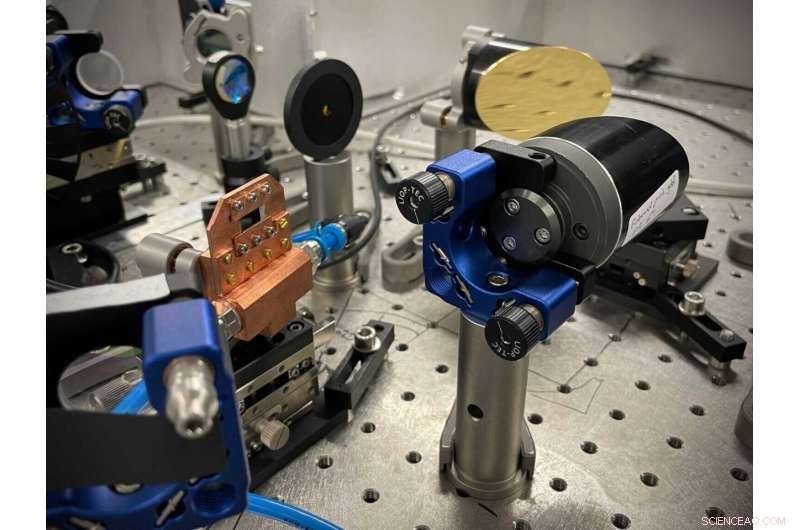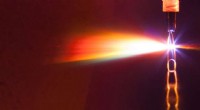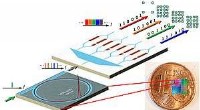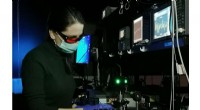
Wetenschap
Het emuleren van onmogelijke unipolaire laserpulsen maakt de weg vrij voor het verwerken van kwantuminformatie

De halfgeleider nanosheets in de watergekoelde koperen houder veranderen een infrarood laserpuls in een effectief unipolaire terahertz-puls. Het team zegt dat hun terahertz-zender zou kunnen worden gemaakt om in een luciferdoosje te passen. Credit:Christian Meineke, Huber Lab, Universiteit van Regensburg
Een laserpuls die de inherente symmetrie van lichtgolven omzeilt, zou kwantuminformatie kunnen manipuleren, waardoor we mogelijk dichter bij kwantumcomputers op kamertemperatuur komen.
De studie, geleid door onderzoekers van de Universiteit van Regensburg en de Universiteit van Michigan, zou ook conventionele computers kunnen versnellen.
Quantum computing heeft het potentieel om oplossingen te versnellen voor problemen waarbij veel variabelen tegelijkertijd moeten worden onderzocht, waaronder het ontdekken van medicijnen, weersvoorspelling en encryptie voor cyberbeveiliging. Conventionele computerbits coderen ofwel een 1 of een 0, maar kwantumbits of qubits kunnen beide tegelijkertijd coderen. Dit stelt kwantumcomputers in wezen in staat om meerdere scenario's tegelijk te doorlopen, in plaats van ze achter elkaar te onderzoeken. Deze gemengde toestanden duren echter niet lang, dus de informatieverwerking moet sneller zijn dan elektronische circuits kunnen opbrengen.
Hoewel laserpulsen kunnen worden gebruikt om de energietoestanden van qubits te manipuleren, zijn er verschillende manieren van berekenen mogelijk als ladingsdragers die worden gebruikt om kwantuminformatie te coderen, kunnen worden verplaatst, inclusief een benadering bij kamertemperatuur. Terahertz-licht, dat zich tussen infrarood- en microgolfstraling bevindt, oscilleert snel genoeg om de snelheid te leveren, maar de vorm van de golf is ook een probleem. Elektromagnetische golven zijn namelijk verplicht om oscillaties te produceren die zowel positief als negatief zijn, die optellen tot nul.
De positieve cyclus kan ladingsdragers, zoals elektronen, verplaatsen. Maar dan trekt de negatieve cyclus de ladingen terug naar waar ze begonnen. Om de kwantuminformatie betrouwbaar te controleren, is een asymmetrische lichtgolf nodig.
"Het optimum zou een volledig directionele, unipolaire 'golf' zijn, dus er zou alleen de centrale piek zijn, geen oscillaties. Dat zou de droom zijn. Maar de realiteit is dat lichtvelden die zich voortplanten moeten oscilleren, dus we proberen the oscillations as small as we can," said Mackillo Kira, U-M professor of electrical engineering and computer science and leader of the theory aspects of the study in Light:Science &Applications .
Since waves that are only positive or only negative are physically impossible, the international team came up with a way to do the next best thing. They created an effectively unipolar wave with a very sharp, high-amplitude positive peak flanked by two long, low-amplitude negative peaks. This makes the positive peak forceful enough to move charge carriers while the negative peaks are too small to have much effect.
They did this by carefully engineering nanosheets of a gallium arsenide semiconductor to design the terahertz emission through the motion of electrons and holes, which are essentially the spaces left behind when electrons move in semiconductors. The nanosheets, each about as thick as one thousandth of a hair, were made in the lab of Dominique Bougeard, a professor of physics at the University of Regensburg in Germany.
Then, the group of Rupert Huber, also a professor of physics at the University of Regensburg, stacked the semiconductor nanosheets in front of a laser. When the near-infrared pulse hit the nanosheet, it generated electrons. Due to the design of the nanosheets, the electrons welcomed separation from the holes, so they shot forward. Then, the pull from the holes drew the electrons back. As the electrons rejoined the holes, they released the energy they'd picked up from the laser pulse as a strong positive terahertz half-cycle preceded and followed by a weak, long negative half-cycle.
"The resulting terahertz emission is stunningly unipolar, with the single positive half-cycle peaking about four times higher than the two negative ones," Huber said. "We have been working for many years on light pulses with fewer and fewer oscillation cycles. The possibility of generating terahertz pulses so short that they effectively comprise less than a single half-oscillation cycle was beyond our bold dreams."
Next, the team intends to use these pulses to manipulate electrons in room temperature quantum materials, exploring mechanisms for quantum information processing. The pulses could also be used for ultrafast processing of conventional information.
"Now that we know the key factor of unipolar pulses, we may be able to shape terahertz pulses to be even more asymmetric and tailored for controlling semiconductor qubits," said Qiannan Wen, a Ph.D. student in applied physics at U-M and a co-first-author of the study, along with Christian Meineke and Michael Prager, Ph.D. students in physics at the University of Regensburg. + Verder verkennen
Light could make semiconductor computers a million times faster or even go quantum
 Uitdaging voorspelt hoe metalen met complexe vormen en fabricage zullen breken
Uitdaging voorspelt hoe metalen met complexe vormen en fabricage zullen breken Typen zeeweringen
Typen zeeweringen  Lab-on-paper strook:Klein, goedkoop platform voor het diagnosticeren van tropische koortsen
Lab-on-paper strook:Klein, goedkoop platform voor het diagnosticeren van tropische koortsen Samengestelde metalen schuimen nemen de hitte, dichter bij wijdverbreide toepassingen komen
Samengestelde metalen schuimen nemen de hitte, dichter bij wijdverbreide toepassingen komen 4D-geprint thermiet kan lassen in de ruimte en gevechtszones gemakkelijker maken, veiliger
4D-geprint thermiet kan lassen in de ruimte en gevechtszones gemakkelijker maken, veiliger
 Waarom wordt suikerwater gemaakt voor kolibries bewolkt?
Waarom wordt suikerwater gemaakt voor kolibries bewolkt?  Onderzoekers identificeren Afrikaans stof door isotopen te meten
Onderzoekers identificeren Afrikaans stof door isotopen te meten Bescheiden opwarming riskeert onomkeerbaar ijskapverlies, studie waarschuwt
Bescheiden opwarming riskeert onomkeerbaar ijskapverlies, studie waarschuwt De mist opheffen over het logge luchtvervuilingsprobleem van China
De mist opheffen over het logge luchtvervuilingsprobleem van China Belang van de oostelijke woestijn in het oude Egypte
Belang van de oostelijke woestijn in het oude Egypte
Hoofdlijnen
- Wetenschappers ontwikkelen microben om herinneringen aan hun omgeving te vormen
- Bacteriën op afstand houden in Hawaiiaanse wateren
- Biologen pakken wereldwijde uitstervingscrisis aan
- Onderzoek onthult hoe cellen zich herbouwen na mitose
- Oude Egyptische zwangerschapstest overleefde millennia omdat het werkte
- De belangrijkste componenten van het skeletsysteem
- Het voortbestaan van de bedreigde monarchvlinder hangt af van instandhouding buiten de grenzen
- Wat breekt een dubbele DNA-helix uiteen?
- Kwam Eiwit, DNA of RNA als eerste?
- Eerste onderzoek naar terahertz-straling in vloeistoffen

- Optische communicatie met recordhoge snelheid via soliton-frequentiekammen gegenereerd in optische microresonatoren

- Nieuw optisch apparaat kan helpen bij het opsporen van drugs, chemicaliën voor het maken van bommen en meer

- Wetenschappers ontwikkelen methode om ladingsvallen in organische halfgeleiders te detecteren

- De soorten eenvoudige machines in uw huis

 Variabele winden op hete gigantische exoplaneet helpen bij het bestuderen van magnetisch veld
Variabele winden op hete gigantische exoplaneet helpen bij het bestuderen van magnetisch veld Hoe beïnvloeden je hersenen je overlevingskansen in de wildernis?
Hoe beïnvloeden je hersenen je overlevingskansen in de wildernis?  Kun je een gat graven tot aan de aardmantel?
Kun je een gat graven tot aan de aardmantel?  Hoe een metrische schaal te gebruiken Ruler
Hoe een metrische schaal te gebruiken Ruler Waar worden barmagneten voor gebruikt?
Waar worden barmagneten voor gebruikt?  NASA's S-MODE gaat de lucht en de zee in om oceaanwervelingen te bestuderen
NASA's S-MODE gaat de lucht en de zee in om oceaanwervelingen te bestuderen Kan wiskunde voorspellen wat je hierna gaat doen?
Kan wiskunde voorspellen wat je hierna gaat doen? Wetenschappers werken samen om de nauwkeurigheid van optische radar te vergroten
Wetenschappers werken samen om de nauwkeurigheid van optische radar te vergroten
- Elektronica
- Biologie
- Zonsverduistering
- Wiskunde
- French | Italian | Spanish | Portuguese | Swedish | German | Dutch | Danish | Norway |

-
Wetenschap © https://nl.scienceaq.com

